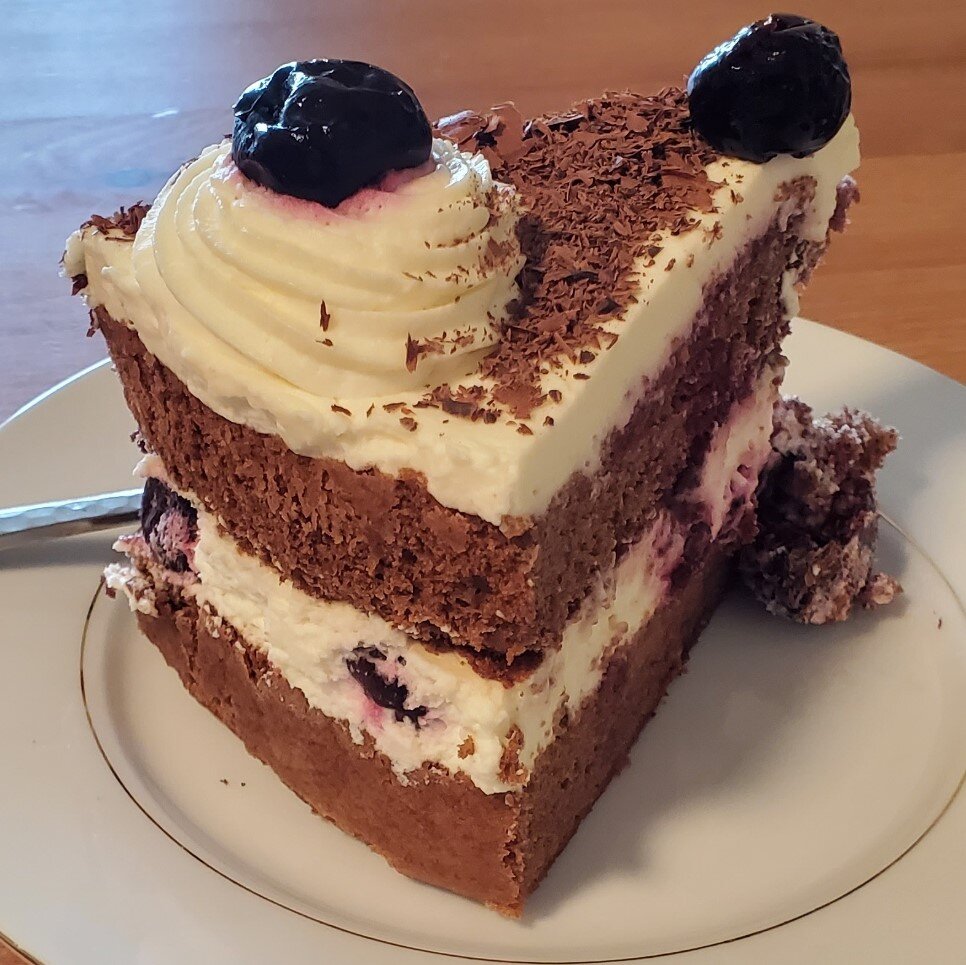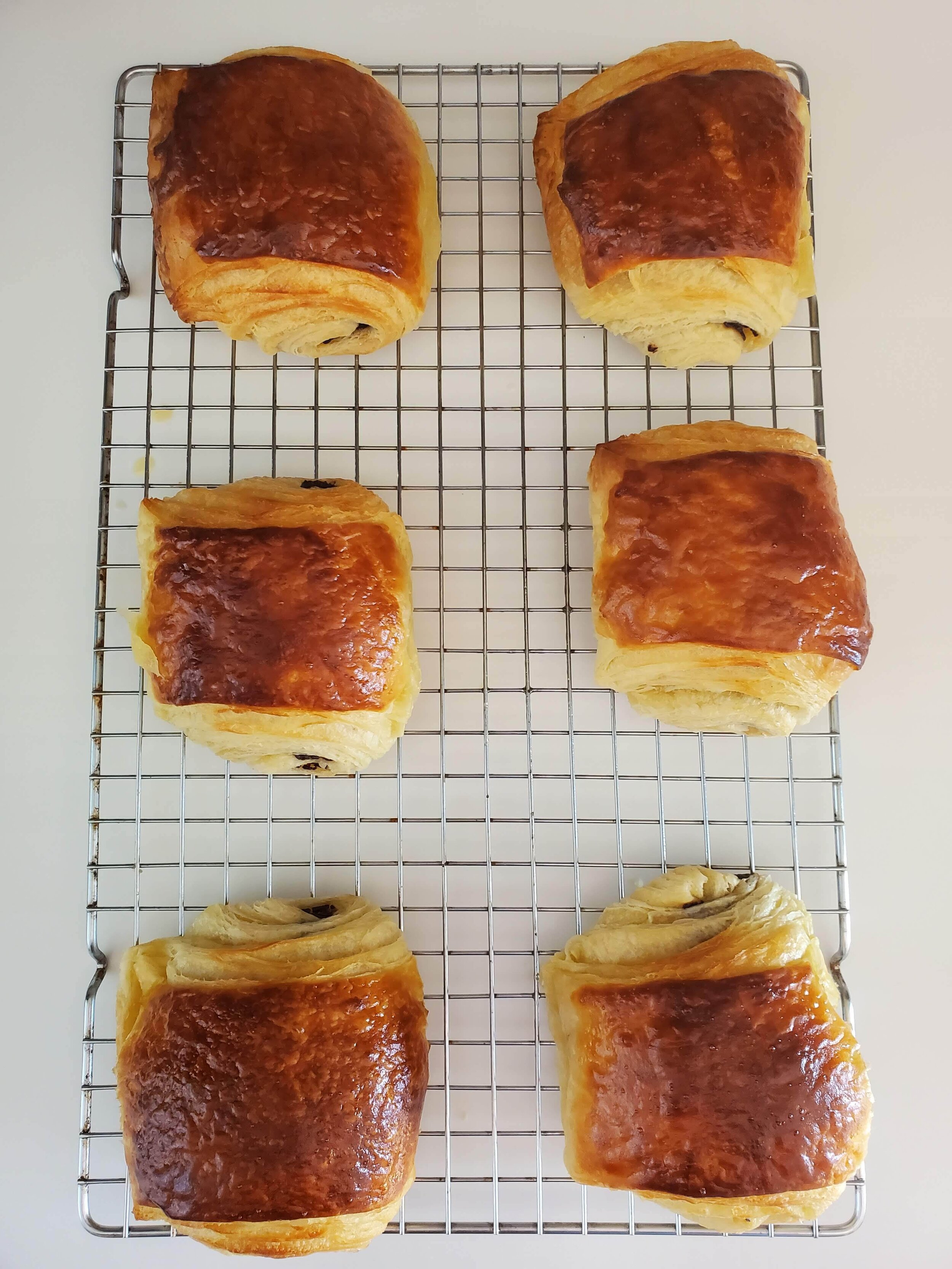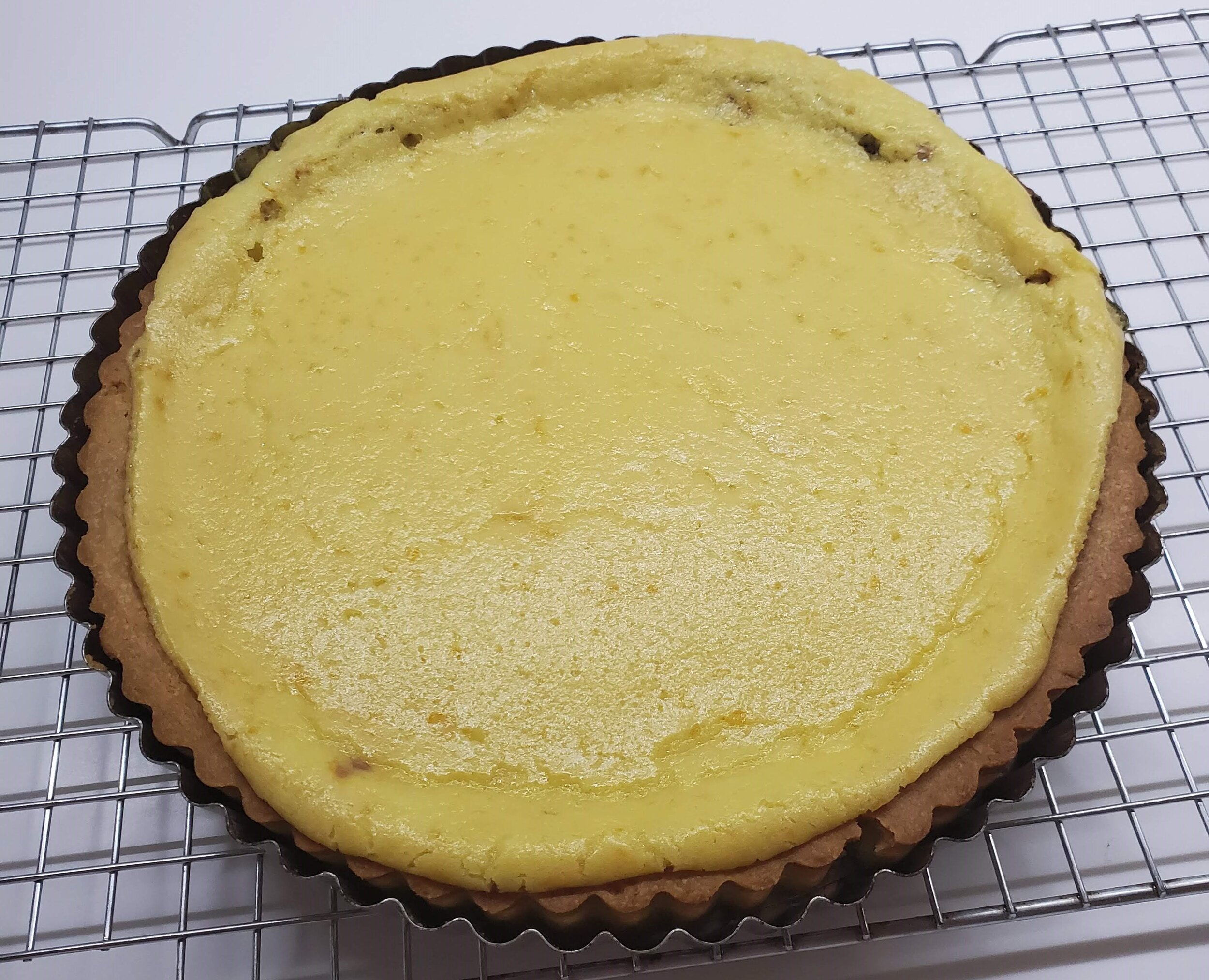
I have always loved to bake.
At times I am seized by the desire to bake an old favorite, something I can whip up with my eyes closed. Other days, I want an hours- or days-long project that will keep me working until the last batch is out of the oven. Often this latter whim comes when I should be doing something more productive. Someone wittier than I called it “procrastibaking.” Behold, my procrastination…
sweet potato flatbread


Our farm box has been sending us copious sweet potatoes recently, including this obscenely large specimen, so I’ve been desperate to cook and eat them. Luckily, Claire Saffitz has a recipe for pillowy soft flatbreads in her Dessert Person cookbook that uses mashed sweet potato. So we had a few friends over for dinner and made an all-sweet-potato meal (dinner salad with radicchio and sweet potato, sweet potato scones from the fantastic Tanya Holland’s Brown Sugar Kitchen cookbook, and these flatbreads). In point of fact, I didn’t even make these flatbreads - Andy did! But given that California is a community property state, I think I’ll include them here anyway.
a return to the familiar - kouignoù amann


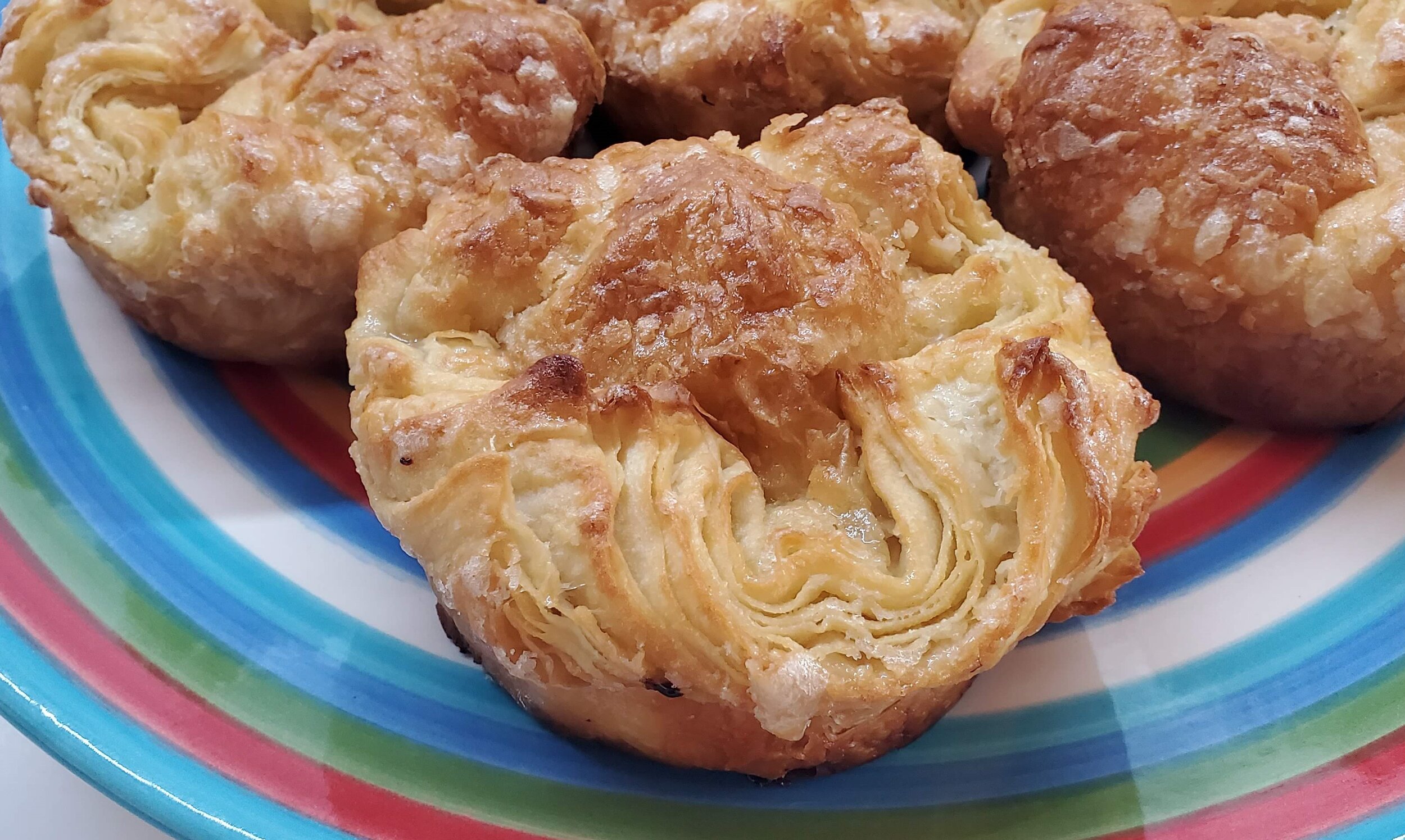

In light of my recent disappointment in baking, I decided to return to a familiar recipe. This was the first one that I baked out of Rose Levy Beranbaum’s the Baking Bible several years ago. These pastries are a true delight, as they are crispy but also a little chewy because of the caramel that arises naturally from the baking process. They’re really straight-forward to make, once you have a handle on laminated, yeast dough. I would highly recommend them to anyone who wants a little joy and brilliance at home.
black sesame Paris-Brest
This is a recipe that I was challenged to make by my friend Dominique, who sends not just amazing postcards but also culinary inspiration! A Paris-Brest is a famous French dessert comprised of a wheel (it’s named after a famous bicycle race between the two French cities) made of pâte à choux, cut open and layered with crème pâtissière mixed with praliné. Then sometimes whipped cream is piped on top and the lid is replaced.
This is a recipe from Claire Saffitz’ Dessert Person cookbook which calls for substituting the praliné with black tahini. She writes that it gives a nutty, somewhat bitter flavor which offsets the sweetness of the whipped cream and the dessert in general. She says it’s a great recipe because the dessert itself is familiar but it’s got an unfamiliar and surprising twist. I was eager to try it, since I love tahini and the photo was so enticing with the charcoal-colored crème pâtissière against the stark white whipped cream.
So I searched high and low for the black tahini, finally finding a jar at my local Middle Eastern grocer. The black tahini - or qizha as it can also be labeled (although they may actually be different products?) - is actually made of Nigella seeds and black sesame seeds ground up, and it really looks like black paint, it’s so black. I was truly intrigued!
Sadly, this recipe did not live up to the hype. The qizha was really bitter and the flavor unfamiliar. I was distracted by it. The choux also doesn’t have the structure to hold up to such a large format - it was floppy even though it was cooked through and the crust was crispy. Saffitz recommends cutting the ring into eighths, but these slices were massive, so I ended up halving the slices again to sixteen. We had a small gathering of eight people total on Sunday and only three pieces were eaten. Once guest said they liked it overall, but it was too intense. Maybe they were being polite?
So, I have to say this may be the first big miss from a cookbook I have really grown to love. I’m certainly not throwing out the cookbook by any means, but the next time I want to make a Paris-Brest, I think I’ll stick to the original recipe.
peach galette


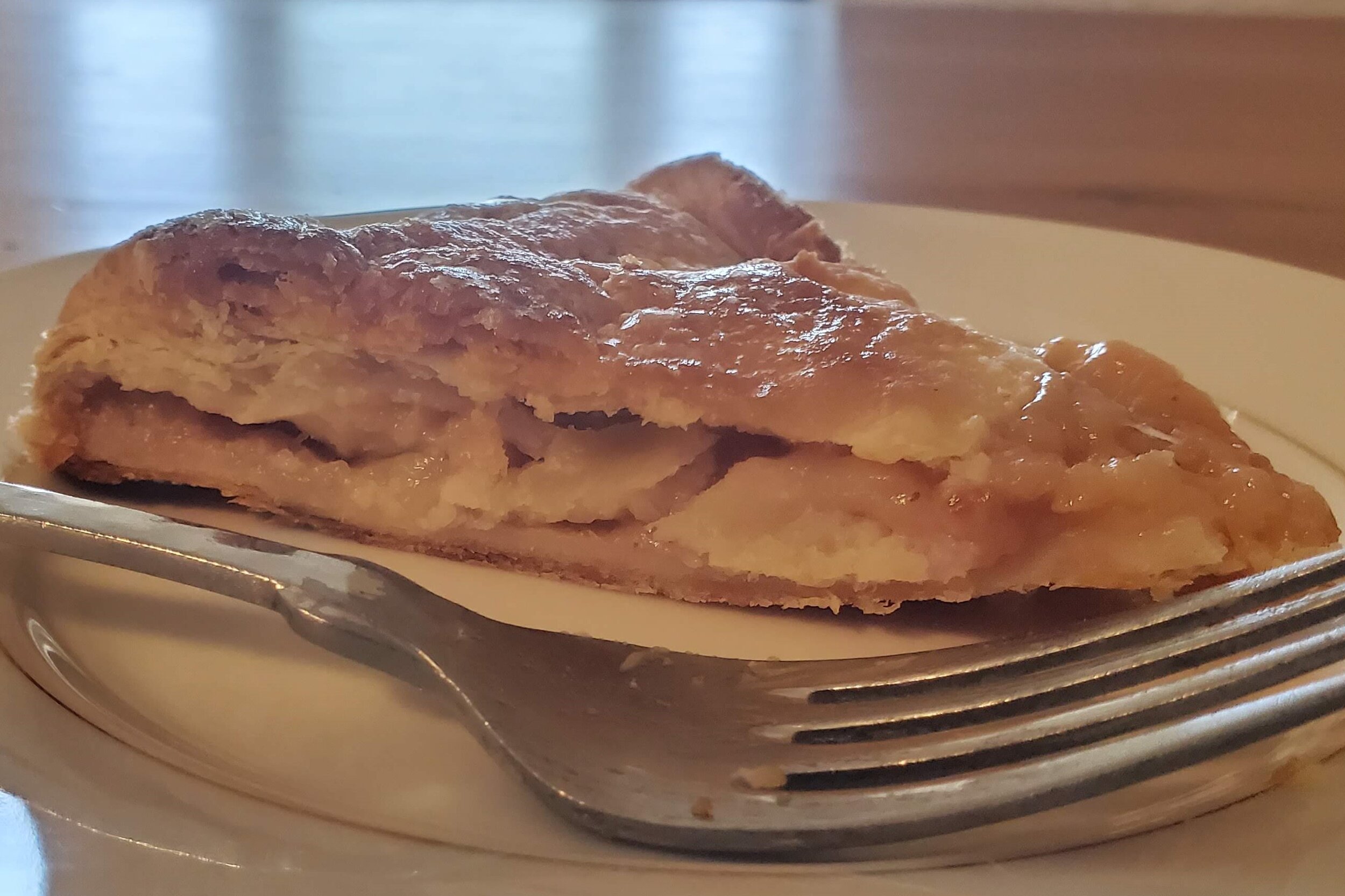

Here’s another recipe from the inimitable Rose Levy Beranbaum’s the Baking Bible: a peach galette. Our CSA sent us peaches this past week and I could think of no better way than to use them than to bake them into this terrifically flaky crust with a little lemon, sugar, corn starch, and almond extract! It’s been a great lunch (and dinner!) dessert these past two days.
What’s in our farm box this week? Nectarines!
pecan sticky buns
We recently went to visit two friends who just welcomed a baby this year; they were preparing brunch for us and I decided to bring a brunch-like dessert: pecan sticky buns.
I adapted it from Claire Saffitz’s recipe for walnut sticky buns in Dessert Person and it just came together so fantastically! The night before, when I was mixing the dough, I forgot to add the eggs until the very end! I put them in the mixed and started mixing and for a few minutes, I thought I was going to have to throw it all out and start over again. But with a little persistence, it finally came together.
The assembly is very easy and came together like a dream. The buns are soft and tender, which I’ve found to be rare in homemade cinnamon roll recipes, so I certainly recommend this one!
Schwarzwalder Kirschtorte
My longtime penpal, Dominique, has taken to sending me YouTube videos of recipes that he recommends I try. This one came in about a month ago and I was very intrigued, as I love cherries and whipped cream, so what’s not to love? I didn’t end up using the exact recipe from the YouTube clip, instead opting for a recipe writer whose work I’m more familiar with: Rose Levy Beranbaum. This recipe, Schwarzwalder Kirschtorte, comes from the Cake Bible, which I don’t own but instead borrowed digitally from the library.
The recipe is a trek, starting with the chocolate génoise. Strangely, the recipe calls for boiling semisweet chocolate in water! I was sure it wouldn’t work, but true to her word, she lead me to a thick, pudding like mix in to the beaten eggs with a little flour.
The brandied cherries were a lot of fun; I used frozen cherries and drained the juice from them, adding a bit of sugar, water, and Kirschwasser. This I boiled down until quite thick and concentrated, and then steeped the cherries in the syrup with more Kirschwasser for a few days. I still have a small jar of these cherries left that I’ll be using for cocktails!
The old-fashioned whipped cream recreates the higher fat whipping cream of yore. Most whipping cream in the US is 37% butterfat, but prior to ultrapasteurization, the butterfat content was higher. So to replicate that, and make a whipping cream that stands up to time a bit longer, you add in melted (and cooled) butter along with your whipping cream. Again, I found the idea puzzling, but it’s absolutely delicious!
Shortly after Andy had cleaned the floors, I remembered to make what Beranbaum calls “snowflakes” which are tiny shavings of dark chocolate, which I promptly got all over his nice, clean floors. Then, to make matters worse, I forgot to sprinkle them on the cake when I decorated and served it! So instead, we sprinkled them on the remaining half a day later and our future pieces will have the chocolate shavings on them.
This cake is not quick, but it is pretty simple. I highly recommend this for your next party.
pigs in a blanket
As I wrote in a previous post, we hosted some friends for a small gathering. Andy had the good idea of making pigs in a blanket, so I decided to use Claire Saffitz’s recipe, which uses brioche dough for the breading! Brioche is certainly not my favorite dough to work with, as it’s soft and very fatty, so it’s a mess. But this was worth all the trouble, even if my wrapping skills were not ideal. The dipping sauce, which I thought was fine, was apparently a very big hit. Nearly equal parts sour cream and spicy brown mustard, a smidge of honey, and salt and cayenne to taste. These were a bit hit, so I’ll probably be making them again for our next gathering!
sourdough bread
Baking sourdough bread isn’t a big event for me, as I’ve been baking sourdough weekly since the pandemic began (yes, I’m one of those!). The truth is that I’ve been baking bread for decades, but it was only during the pandemic that I finally found the courage to make a true sourdough with no yeast at all. But this past weekend, we hosted some friends for a small gathering and I made a loaf of sourdough for the cheese and charcuterie that we had. It looks great, so I decided to take some photos.
nectarine and blueberry clafouti
Because I had leftover blueberries from last week’s pie and we had received some nectarines from our CSA, I decided at the last minute this morning to make a clafouti. I definitely winged it with the recipe and I wasn’t expecting it to turn out very good. I doubled the fruit amount but only 1.5 the batter amount. I didn’t want to open a whole bottle of Riesling just to macerate the fruit, so I made my own soak out of some grenadine I’d made last year, some lemon juice, and some simple syrup. I had intended to keep the soak for a cocktail tonight but when I wasn’t paying attention, I put the rubber spatula into the bowl after I’d scraped the batter into the pan, so I had to throw it out. I didn’t expect it to taste very good, honestly, because the nectarines were a bit under-ripe and I’d played fast and loose with the recipe (cutting back some butter, adding a bit extra flour), so I didn’t take a photo when it came out of the oven. But Andy and I both really liked it, so I may be making this again in the future, despite it not being that beautiful! I could always cover it up with a scoop of ice cream. :-)
black and blue pie
This was the first pie I made out of Rose Levy Beranbaum’s “the Baking Bible” book and her pie dough recipe blew me away. It calls for apple cider vinegar (not that surprising in fact) and cream cheese, which was something I was skeptical of! But the resulting crust is terrific and the method, using a food processor, is absolutely fool proof. It is absolutely my go-to pie crust recipe now.
As for the filling, it’s dead simple: blackberries, blueberries, lemon zest, lemon juice, sugar, and corn starch. This is a pie for the ages, folks.
perfect pound cake



I’ve been trying to find another pound cake recipe since we’ve been having trouble with the results of a favorite family recipe. This one is from the ever reliable Rose Levy Beranbaum, in her Cake Bible book. The recipe is very straight-forward and simple, and it baked up just as she promised. It’s light and tender and the flavor is delicious. I baked them in small bundt-lettes to make them easier to transport since I’m meeting a friend for an outdoor coffee today.
tarte bourdaloue



My penpal in eastern France encouraged me to try a few new French recipes recently. The first one I tried is tarte bourdaloue, often translated in English as “frangipane pear tart.” Dominique sent a YouTube video which I relied on heavily for this recipe, although I did need a recipe for poached pears, which the recipe assumes you have on hand. To poach pears, you just peel, halve, and core them before simmering them in a syrup of sugar, water, and spices (here: cinnamon, anise, clove, and lemon slices). The crust is a simple pâte sucrée which is not blind baked (I was skeptical). Next you pipe in the frangipane, which is just sugar, butter, eggs, almond extract, and almond flour. On top of this, you later thinly sliced poached pears and top with slivered almonds (which I blanched by myself and then tried unsuccessfully to slice thinly). My tart did take 45 minutes to bake instead of the recommended 30, but this may be due to my thicker crust than in the video.
The flavor is surprisingly delicate for as much sugar as is in this recipe. I liked it a lot, but Andy found it too eggy. I guess I’ll be eating tarte bourdaloue for the rest of the week! It’s not a bad way to spend the week, that’s for sure.
chocolatines
I’ve been enjoying the new kitchen so much and I decided to make another laminated pastry. I also made the mistake of buying a 3 kilogram box of chocolate bars recently, so if I have any hope of actually using them before they bloom, there’s no time like the present! This is my old standby recipe which I learned to make at the San Francisco Baking Institute, which I highly recommend to anyone interested in improving their baking skills. The weekend intensive course isn’t cheap, but you learn so much and I now have the confidence to make laminated pastries whenever I want (kouigns amann, croissants, chocolatines, morning buns, etc.). These aren’t quite as good as the best pastries I can buy in San Francisco, but they’re far better than the pastries I’ve been able to get in almost any other city I’ve lived in (except the obvious). These chocolatines are flaky and buttery, and I’ve been baking them a bit harder than before since I think the fat in them helps keep them moist despite a hard bake.
The joy of this recipe is that you can make them the day before, roll them out and shape them, egg-wash them, and then keep them in the fridge overnight (or over-two-night-s!) and then bake them the next morning after a 90 minute rise in the proofer. So it’s easy to have fresh chocolatines in the morning for a late breakfast or right on time for brunch. Here’s to widespread vaccinations so we can have people over for brunch again!
sour cream and chive dinner rolls
These are a hit, although the recipe makes a ginormous number of rolls. We happened to get some fresh chives in our weekly farm box, so I decided to pick up some sour cream (one of the few dairy products we almost never have in the house) and try my hand. This is a typical, enriched dough made with butter and sour cream, as well as whole milk and a little sugar. The dough is rolled out and finely chopped chives are sprinkled over the dough and then it’s rolled up and divided into twenty-four “equally"-sized” balls. They’re left to proof, salt-and-peppered, and then baked in a heavily-buttered pan, and they come out of the oven just delicious and golden brown (be sure to spread some more butter on top). As I was putting the doughballs in the pan, I realized that this was going to make an enormous number of dinner rolls that Andy and I had no hope to consume in time (although that’s the kind of challenge we typically rise to!), so I decided to do an experiment. I froze eight doughballs on a dinner plate and transferred them to a plastic bag. We’ll see if they rise and shine and bake up as expected in another week or so. If they do, it might be the way to go as this recipe is enormous.
Ultimately, I recommend this recipe by Claire Saffitz from her book Dessert Person.
ugly delicious lemon tart
I almost didn’t upload these photos because the tart is so ugly. I worked really hard on it and it took me days. On Monday, I made the lemon curd, which involves - basically - whisking the damned mixture nonstop for almost forty minutes (because I’m still getting used to the electric stove after cooking on a gas stove for the past fifteen years). Then the lemon curd goes in the fridge to firm up and I made the tart base, which was much easier but of course involved the food processor which, dishwasher or not, is still a pain to clean. The tart dough needs to chill and rest before being blind baked for almost 40 minutes and then cooling completely. Then you patch the inevitable cracks and split with reserved dough before spreading it with raspberry jam. This is then baked, to create an impermeable layer that prevents the tart shell from getting soggy from the lemon curd; the vibrant jam also is supposed to make a clean line between the pale curd and golden tart. Then you whisk the curd with Greek yogurt and pour it into the tart before baking it.
Well, you can see what happened here; the curd filling ballooned up and over the edge of the shell before falling back as it cooled. The beautiful tart shell shrunk from the edges and ultimately cracked; thankfully, no filling leaked out. And the jam layer never solidified, so it just oozed out of the way as I poured in the curd filling, so there was no lovely line of jam. I was so disappointed with this bake; maybe I rushed baking the raspberry jam and I should have let it go longer?
The good news is that, ugly as this tart appears, it was delicious. Andy didn’t like it, which was no surprise since he really only likes citrus to eat as a fruit or drink as a juice. I’m not sure I’ll attempt this recipe again, the first disappointment from Claire Saffitz’ Dessert Person, as it was a pain to make (and what do you do with six egg whites?!) and Andy didn’t love it. All well - you win some, you lose some (and this wasn’t a total loss anyway).
morning buns
Last weekend, I was out for a walk and was struck with a strong desire for a baked good and I stopped into a nearby bakery called Craftsman and Wolves. I bought a morning bun and a coffee (that’s the photo with the coffee cup) and was struck by how delicious it was, and was inspired to try my own hand at is. I looked around for a good recipe and settled on Chic Eats’ adaptation of the very famous Tartine Bakery’s morning bun, which is one of my favorites. I checked out their cookbook and their recipe for croissant dough, which is the base of this recipe, didn’t look significantly different from the recipe I’ve used more than a dozen times with great success so I skipped it and went with my old standard: Thorough Bread and Pastry’s recipe, which I learned to make at the San Francisco Baking Institute almost four years ago exactly (I highly recommend their courses if you’re in the San Francisco Bay Area). The recipe is basically a cinnamon roll that you make with dark brown sugar, granulated sugar, cinnamon, and orange zest and then bake in muffin tins brushed with butter and sprinkled with more granulated sugar. When the buns come out of the oven, you sprinkle them with more granulated sugar - so this recipe is not for those who are hoping to reduce their sugar consumption!
As you can see, they caramelized nicely and they’re doughy and delicious. I ate two yesterday and I’ll have another one today, so I hope that their texture isn’t too negatively impacted by an overnight in an airtight container. But if you’re interested in enjoying some delicious morning buns, I highly recommend this recipe!
rainy day bagels
Today was cold and rainy and I’d bought a giant amount of smoked salmon from Costco this week, so it was a natural choice to make bagels. Contrary to a recent article in the New York Times, I don’t think the West Coast has very good bagels. Those that come close are priced outrageously, sometimes costing up to $5.00 per bagel, plus extras for butter or cream cheese (to say nothing of smoked salmon!)! I used to use a recipe by the linguist and author Arika Okrent, but it was very labor intensive. I was pleased to discover Peter Reinhart’s recipe, which is much more manageable and makes delicious bagels worthy of any Bloomfield Hills deli. Pictured here from left to right are sesame (actually the top-left bagel reminds me of Montreal’s St. Viateur in its shape and coverage!), salt, poppy seed, and everything (poppy seed, sesame seed, garlic, onion, and salt). This morning, we ate them with smoked salmon, cream cheese, dill, capers, red onion, and tomato.
brioche twists - cinnamon or coriander
This weekend, I made Claire Saffitz’ brioche twists recipe from her Dessert Person book. The recipe calls for ground coriander seed to be mixed with demerara sugar for the topping and I was skeptical. Coriander (fun fact: in the US, “coriander” refers only to the seed; the leaf is called “cilantro”; but other English speakers use “coriander” for both the leaf and the seed!) for me has always been a savory spice, and I was worried the brioches would be strange. So I did 1/2 and 1/2, also remembering that Andy is addicted to cinnamon-sugar. The coriander half turned out more beautiful with their golden, shimmering sugar coating. The cinnamon half were a bit darker and patchier in coverage, but both are equally delicious. The dough itself is lightly sweet so without the spice-sugar coating, it could certainly be used for a savory application! Brioche is no joke to work with - I found myself very frustrated with its stickiness until I finally let go of my pride and floured the countertop a bit.
King Cake from New Orleans
I seldom post photos of things I didn’t bake, but this one deserves an exception. Our fantastic friend Kaylé ordered us a king cake all the way from Louisiana so we could celebrate Mardi Gras properly! The king cake came baked and un-iced — of course, as you can tell from my amateur hour icing job — with sprinkles and even a small baby to hide in the cake! I didn’t grow up with the tradition of king cakes, but I so love it! This one was cinnamon flavor and light and mildly sweet (more so with the icing) and was a great way to responsibly celebrate Mardi Gras at home. Next year I hope to be able to give Kaylé a homemade king cake as thanks for her consistently bringing me happiness and good cheer.
pecan brittle oat cookies
Claire Saffitz writes that it’s a rare recipe that merits not one but two pieces of specialized, heavy equipment. I was of course skeptical of even this claim, but eventually I did make these cookies at my friend Bryan’s insistence. First you make a homemade brittle with butter, sugar, water, then toasted pecans, salt, and baking soda. Once it’s cooled, you break it into small pieces and halve it. Set aside half with some old fashioned oats; the other half you blitz in a food processor with flour, oats, salt, and baking soda. Cream some brown butter with softened raw butter, add the sugars, and finally your dry ingredients. To add insult to injury, you refrigerate the dough overnight (a standard procedure for our household, but maybe not for most people) before baking. They’re not much to look at, but my husband—who has never been a fan of caramel or brittle—loves these cookies. Give them a try when you buy or check out Dessert Person.





